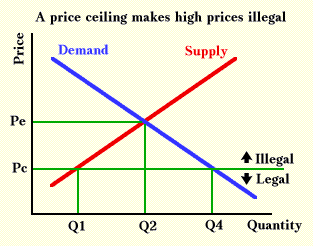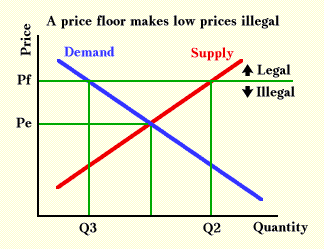Price as a Rationer
There have been many cases throughout history in which governments have been unwilling to let markets adjust to market-clearing prices. Instead, they have established either price ceilings, which are prices above which it is illegal to buy or sell, or price floors, which are prices below which it is illegal to buy or sell.
If a price ceiling is placed below the market-clearing price, as Pc is in the picture below, the market-clearing price of Pe becomes illegal. At the ceiling price, buyers want to buy more than sellers will make available. In the graph, buyers would like to buy amount Q4 at price Pc, but sellers will sell only Q1. Because they cannot buy as much as they would like at the legal price, buyers will be out of equilibrium. The normal adjustment that this disequilibrium would set into motion in a free market, an increase in price, is illegal; and buyers or sellers or both will be penalized if transactions take place above Pc. Buyers are faced with the problem that they want to buy more than is available. This is a rationing problem.

Price ceilings are not the only sort of price controls governments have imposed. There have also been many laws that establish minimum prices, or price floors. The graph below illustrates a price floor with price Pf. At this price, buyers are in equilibrium, but sellers are not. They would like to sell quantity Q2, but buyers are only willing to take Q3. To prevent the adjustment process from causing price to fall, government may buy the surplus, as the U.S. government has done in agriculture and in precious metals. If it does not buy the surplus, government must penalize either buyers or sellers or both who transact below the price floor, or else price will fall. Because there is no one else to absorb the surplus, sellers will.

Rationing is necessary to deal with scarcity.1 When an item is scarce, people must sacrifice something in order to get as much of the item as they would like to have. There are some goods that are not scarce. Air is an example--it is free to all who want to breathe it. Ice is not scarce in Greenland. But almost all other goods are scarce. Price is a way to ration goods. It deprives those who do not have enough income or desire for a product. The function of price as a rationer is most clearly seen when price is prohibited from acting as a rationer, so that some other method of rationing (such as queuing or coupon rationing) must emerge or be developed.
1Note that scarcity is not the same as shortage. Scarcity exists whenever some rationing process must be used. A shortage indicates that price is below market-clearing price.